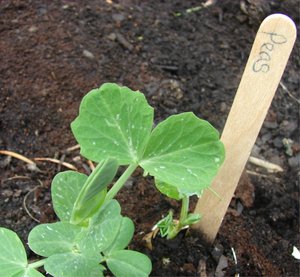Sugar snap peas fresh from the garden are crisp and tender ready for eating straight from the vine or in your favorite recipe. Although I wouldn’t trade them for regular peas, these tender morsels are bursting with flavor and add distinctive color and texture to stir-fried vegetables.
Location: Choose a sunny location with humus-rich, well-drained soil for planting sugar snap peas. Although they will tolerate light shade – and prefer cool weather – sugar snap peas require at least 6 to 8 hours of direct sunlight a day. Morning sun is preferred, as these plants suffer in hot afternoon sun – particularly if grown in containers. Moist soil is the key to healthy sugar snap peas.
Soil preparation: Till the soil to a depth of 8 to 10 inches and remove any foreign objects, such as stones, roots and plant debris. Rake the area smooth and apply two to three inches of well-rotted manure or compost over the soil. Work this into the top six inches of the soil. Add 5-10-10 or 10-10-10 fertilizer following the application rate on the container. Work the fertilizer into the soil well, as contact with plant parts causes damage to the plant.
Preparing pea seed: Pour the pea seeds into a large bowl with a volume approximately twice that of the peas. Cover with lukewarm water and allow the seeds to soak overnight. Dried pea seeds absorb moisture from the water and swell to twice their size preparing them for quick germination.
Planting: Sow the seeds in the prepared garden bed as soon as the soil can be worked. These cool season plants tolerate late spring frosts and grow best before the weather warms. Plant seeds to a depth of one inch and cover with soil. Tamp the soil down to secure the seeds. Water to moisten the soil, if necessary.
Fertilizer: Side dress sugar snap peas with 5-10-10 fertilizer when they are two to four inches tall. Sprinkle a narrow band of fertilizer along the row – about four inches from the base of the plants – and work it into the top two inches of soil with a garden hoe.
Watering: Water snap peas deeply once or twice a week to keep the soil evenly moist. Consistent watering is vital to pod production. Do not allow soil to dry excessively – particularly once the plants bloom, as ample water is needed to produce plump, crisp pods.
Harvesting: Harvest snap peas when the peas are visible through the sides of the pods – but before they become overgrown. Sugar peas should be plump, juicy and slightly firm. Test the maturity of your peas by picking a pod and sampling it right from the vine. One bite should release a burst of juicy flavor while producing the characteristic “snap” as you break the skin.
Cooking: Wash sugar snap peas under cold running water to remove any garden residue. Add the entire pod to stir-fries or steam them in a steamer until the pods are crisp tender.
Preserving: The best way to preserve sugar snap peas is freezing, as this retains both the flavor and color of the peas. Blanch the pods in boiling water for two minutes and then plunge them into ice water to cool thoroughly. Drain to remove excess moisture and freeze in freezer bags. Use frozen snap peas in any recipe that calls for snow peas.
More work by this author:
How to Grow Potatoes in Containers
How to Water a Garden: Deep Watering Promotes Healthy Roots
Gardening in Maine






